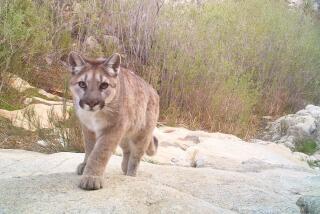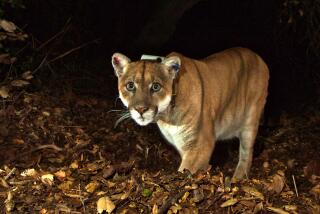The hidden consequences of hunting Africa’s lions
After the global uproar over the death of a Zimbabwean lion dubbed Cecil, the hunting industry had a response: By killing animals, trophy hunters are actually saving Africa’s wildlife.
Trophy hunting, the industry contended, gives the animals an economic value to local communities, which otherwise see them as hated vermin to be exterminated at all costs. So although some are killed by hunters, greater numbers are saved.
But one body of research suggests an alternative hypothesis: Hunting, as currently practiced, has hidden consequences that take a far greater toll on lion populations than people realize.
Craig Packer, director of the Lion Research Center at the University of Minnesota, has led a series of studies identifying over-hunting as the major reason for the steep decline in lion populations in Tanzania, the biggest lion-hunting country in Africa. At the root of the problem, he believes, is the preference of trophy hunters for large male lions, the dominant animals in a pride.
When a hunter kills and takes home one big male trophy, other males fight and kill one another for dominance, Packer said. The male lions might also kill off the cubs and attack females who try to defend them. In Tanzania, Packer said, the big, older trophy males became so depleted that hunters started killing immature maneless lions.
“If you are shooting that many young males, it means you’ve shot all the big ones. It was incredibly poorly managed. It’s a very efficient way to promote the social instability that will cause a population to decline,” he said in a telephone interview.
Julian Rademeyer, author of “Killing for Profit,” a book about poaching in southern Africa, said professional hunters face huge pressure to ensure that foreign hunters bag the big trophies they’re after. Professional hunters in Zimbabwe were arrested for their role in the bowhunting death of Cecil, a large, dominant lion, by American dentist Walter Palmer.
“They will do pretty much anything to get your trophy. There’s immense pressure on hunting outfits to get those trophies,” Rademeyer said. “It’s meant to be regulated use and sustainable hunting. In instances where you have widespread corruption and regulations are not adhered to, it just becomes a killing frenzy and that’s what’s happening in Zimbabwe.”
From 2002 to 2009, 1,363 lion trophies were exported from Tanzania, but the figure ignores the many lions that were killed in the aftermath of hunts, and the effect on breeding. According to Packer’s research, intensive hunting has caused sharp declines in lion populations in Tanzania, not just in hunting areas but also in national parks.
According to the International Union for Conservation of Nature, the lion population in Tanzania declined by 66% from 1993 to 2014.
A 2009 study by Packer and other scientists concluded that areas “with the highest intensity of sport hunting have shown the steepest population declines in African lions … over the past 25 years.” A 2011 study he carried out called for reductions in lion hunting quotas, saying that “the intensity of trophy hunting was the only significant factor” in declines in male trophy lions.
Packer’s reports led the Tanzanian government to cut hunting quotas and introduce a law against shooting immature males, but he said the law has rarely been enforced because of widespread corruption in the industry.
The global population of lions has dropped from 100,000 in the 1980s to an estimated 30,000, but could be much lower.
In Kenya, where hunting was banned in 1977, the lion population has dropped from 15,000 to about 2,000 in 15 years, a statistic often cited by the hunting industry to demonstrate that hunting is not the problem. In Kenya, lions roam free and often come into conflict with nomadic cattle-herding people, who kill them with poison to protect the cattle.
By contrast, South Africa, which has a big trophy hunting industry popular with Americans, has about 9,000 lions, nearly a third of the global total, and the Professional Hunters’ Assn. of South Africa says that trophy hunts contribute about $90 million to the economy.
However, only about 2,800 of South Africa’s lions are wild. Nearly 70% are captive bred, often used as cubs in petting zoos, then sold off to “canned hunting” outfits where foreign trophy hunters pick off semi-tame lions fenced into small areas, in a practice likened to dynamiting fish.
And critics contend that trophy hunting brings little economic benefit to local communities.
“That’s the biggest myth about sport hunting, that it gives value to lions,” Packer said.
A 2013 study by Economists at Large, an Australian organization of conservation-minded economists, found that on average only 3% of money generated by trophy hunting winds up in the hands of local people. It formed only 1.2% of all tourism revenue in South Africa, 2.3% in Tanzania and 3.2% in Zimbabwe, the study found.
“We see that across Africa, local communities receive minimal benefit from trophy hunting, particularly when we consider the vast areas of land that hunting concessions occupy,” the report said.
More to Read
Start your day right
Sign up for Essential California for news, features and recommendations from the L.A. Times and beyond in your inbox six days a week.
You may occasionally receive promotional content from the Los Angeles Times.






